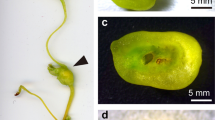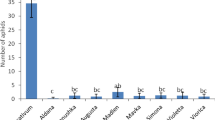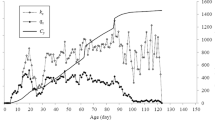Abstract
THE extensive investigations of Lord Todd and his colleagues1 have shown that several related perylene-quinone pigments, the erythroaphins (Fig. 1), can be obtained from many aphid species; the two most completely investigated representatives, the erythroaphins fb and sl, are stereoisomers of the formula C30H22O8. These pigments, however, are not present in the live insect, but are formed through post-mortem enzymatic transformations of yellow precursors, the protoaphins, which do not contain the perylene nucleus1a. In the course of research on naturally occurring perylenequinones2, we have investigated the pigments of two bright red species of-the aphid genus Dactynotus, since it seemed possible that their colour might be due to preformed perylenequinones. Earlier, Todd et al.3 had observed the occurrence of very small amounts of aphin pigments in D.jaceae; D. cirsii, however, was found to contain instead a red pigment which has not been described in detail but which, from its uncharacteristic absorption spectrum, is not a perylenequinone.
This is a preview of subscription content, access via your institution
Access options
Subscribe to this journal
Receive 51 print issues and online access
$199.00 per year
only $3.90 per issue
Buy this article
- Purchase on Springer Link
- Instant access to full article PDF
Prices may be subject to local taxes which are calculated during checkout
Similar content being viewed by others
References
(a) Lord Todd, Experientia, 18, 433 (1962). (b) Cameron, D. W., Kingston, D. G. I., Sheppard, N., and Lord Todd, J. Chem. Soc., 98 (1964) and earlier papers.
Batterham, T. J., and Weiss, U., Proc. Chem. Soc., 89 (1963). Weiss, U., et al., Canad. J. Microbiol., 11, 57 (1965).
Duewell, H., Human, J. P. E., Johnson, A. W., MacDonald, S. F., and Todd, A. R., J. Chem. Soc., 3304 (1950).
Palmer, L. S., and Knight, H. H., J. Biol. Chem., 59, 451 (1924).
Roberts, J. C., and Warren, C. W. H., J. Chem. Soc., 2992 (1955).
Cameron, D. W., Cromartie, R. I. T., Hamied, Y. K., Scott, P. M., Sheppard, N., and Lord Todd, J. Chem. Soc., 90 (1964).
Barlow, J. S., Canad. J. Biochem., 42, 1365 (1964).
Strong, F. E., Hilgardia, 34, 43 (1963).
Author information
Authors and Affiliations
Rights and permissions
About this article
Cite this article
WEISS, U., ALTLAND, H. Red Pigments of Dactynotus rudbeckiae and D. ambrosiae[Homoptera, Aphididae]. Nature 207, 1295–1297 (1965). https://doi.org/10.1038/2071295b0
Issue Date:
DOI: https://doi.org/10.1038/2071295b0
This article is cited by
-
Fungal perylenequinones
Mycological Progress (2022)
-
Antifungal sorbic acid containing glyceride in aphids
Die Naturwissenschaften (1971)
-
Haemolymph Pigments of Aphids
Nature (1966)
Comments
By submitting a comment you agree to abide by our Terms and Community Guidelines. If you find something abusive or that does not comply with our terms or guidelines please flag it as inappropriate.



